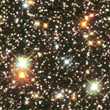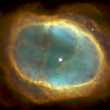|
Astronomy 1Y:
Stellar Astrophysics
The Stellar Astrophysics course deals
with the observations, classification, and modelling of stars and their
evolution. The course divides into two parts. The first part deals with
the basic observations of stars in our galaxy, the different stellar types
and their classification. We discuss the source of luminosity of stars,
the structure of main sequence stars and their evolution off the main sequence.
The second part (called 'Compact Objects' and given by Professor Brown)
deals with the later stages of stellar evolution and the properties of
the so-called compact stars, white dwarfs and neutron stars, and black
holes, and our theoretical understanding of these objects.
|
You will need a password for full access to the following
material.
Requests should be emailed here.
 |
Jump to:
|
 |

Course details
Copies of lecture notes will appear here as the
course proceeds. They are for reference only, and should be
used to replace your own lecture notes. You will find the course much harder
if you don't create your own written version, so please do not print these
notes out in quantity.
Measuring the stars
(Carroll & Ostlie chapter 3. Note that some Americans still like
to use the old-fashioned erg as a unit of energy. 1 erg = 10-7 joule.
e.g., page 67 example 3.2, F = 1.360 x 106 erg s-1
cm-2 = 1.360 x 103 J s-1 m-2)
The Sun; range of luminosities, masses and radii; effective
temperatures
Pictures: [ Sagittarius star
field | Betelgeuse ]
Handouts:[ Blackbody radiation and Planck's radiation
law]
Star types
(Carroll & Ostlie, section 8.2)
Hertzsprung-Russell (H-R) luminosity v temperature diagram; main sequence; red
giants; white dwarfs;
Pictures: [protostars | Orion
Nebula | Betelgeuse (red giant) | NGC2440
(white dwarf and planetary nebula) | M4 (cluster containing
white dwafs)]
Handouts: [ The Hertzprung-Russell diagram | A
real Hertzprung -Russell diagram ]
Variable and binary stars; light curves and radial velocity
curves
(Carroll & Ostlie chapter 7)
Pictures: [ SN1987A (supernova)
| Nova Cygni (cataclysmic variable) | Cepheids
in M100 | spectroscopic binary Mizar]
Handouts: [ Periodic variables ]
Stellar atmospheres -photosphere, chromosphere, and corona; absorption;
scattering; line formation
(Carroll & Ostlie chapter 11 and chapter 8)
Pictures:[ solar corona in FeXII
| solar corona during
eclispe ]
Handouts: [The solar atmosphere | Fraunhofer
lines in the visible solar spectrum]
Classification of stars - spectral classification (OBAFGKM);
chemical composition, mass luminosity relationship for main sequence stars
(Carroll & Ostlie chapter 8)
Handouts:[The classification of
stars - Spectral Types | The classification of stars
- Luminosity Class]
Star formation - gravitational collapse, protostars and evolutionary tracks;
free-fall and Kelvin-Helmholtz timescales; T-Tauri stars and bipolar outflows;
emission nebulae
(Carroll & Ostlie chapter 12)
Pictures: [M16 The Eagle Nebula
| protoplanetary disks in Orion | Jets
from young stars | 30 Doradus | Rosette
Nebula ]
Handouts:[Pre-main sequence stellar evolution ]
Stellar models - hydrostatic equilibrium; estimates of central temperatures
of main sequence stars; radiative equilibrium and convection; nuclear fusion;
p-p chain and CNO cycle
(Carroll & Ostlie chapter 10)
Handouts:[ stellar fusion processes
]
Stellar evolution - typical evolution of 1, 5 and 10 solar-mass stars;
lifetimes of stars; H-R diagram and evolution; cluster evolution
(Carroll & Ostlie chapter 13)
Pictures: [ Cats eye nebula |
ring nebula | other planetary
nebulae | SN1987A from afar | SN1987A
shock wave ]
Handouts:[ Post-main sequence stellar evolution |
Evolution in globular clusters | cluster
evolution sequence ]
Supernovae - Sequence
of events leading to a supernova; nuclear photodisintigration,; inverse beta decay;
neutrino production and blast wave; energy budget
(Carroll & Ostlie chapter 13)
Pictures: [ SN1987A before and
after | crab nebula | supernova
remnant Cassiopeia A ]
Degeneracy Pressure - electron degeneracy pressure; the Heisenberg uncertainty
relation and Pauli exclusion principle; relativistic effects
(Carroll & Ostlie chapter 15)
Pictures: [ M4 (cluster containing
white dwarfs)]
White Dwarfs, neutron stars and black holes - The mass and radius of a
white dwarf; Chandrasekhar mass limit; formation of neutron stars; neutron degeneracy
pressure and neutron star internal structure; neutron star mass limit (Oppenheimer
Volkoff limit); black holes; Schwarzschild radius
(Carroll & Ostlie chapter 15 and 16)
Pictures: [ Puppis A
| neutron star ]
Handouts: [ Summary of compact objects ]
Observational evidence for compact objects - white dwarfs; Sirius
B; Properties of neutron stars; conservation of angular momentum; centrifugal
breakup; magnetic field; pulsars; non-thermal radiation; beaming of radiation;
pulsar periods and slowdown rates; the Crab Pulsar; the Binary Pulsar;
the Millisecond Pulsar; appearance of black holes; compact binary X-ray sources
and accretion; supermassive black holes; Hawking radiation
(Carroll & Ostlie chapter 16 and 17)
Pictures: [ first pulsar telescope
(Cambridge) | Crab Nebula | Earth
as a neutron star | LMCX3 | M87
]
Handouts: [Pulsar 1 | Pulsar
2 ]
Audio: [Pulsar
Sounds]
Learning Objectives:
On completion of the course, the student should be able to:
1.describe the main types
of stars, the spectral classifications of stars, and the Hertsprung-Russell
(HR) diagram
2.discuss the physical principles
needed to build simple models of main sequence stars
3.discuss the relationship
between stellar evolution and the HR diagram
4.explain the nature of
gravitational collapse and be familiar with the properties of compact stars
and black holes
5.state the observational
evidence relating to these stellar states
Handouts
Clean copies of the following handouts are available
from the astronomy secretary's office (room 608) as they appear in the
course.
Question
Sheets
Problems for this course can be found in the A1
problems handbook, reproduced here in pdf
format. Note that some of the material in problems listed under 'compact
objects' may not be covered in this course.
Books
There is no single textbook which is an essential purchase
for this module. However An
Introduction to Modern Astrophysics, B W Carroll and D A Ostlie, Addison
Wesley is strongly recommended, and is essential for the Astronomy
2 course It has its own website
here. Its approach is in places more advanced than required for A1X
and Y, however there is much useful material in it.
For wider background reading, students may find the following
list useful:
-
Fundamental Astronomy - 2nd Enlarged Edition, H Karttunen et al, Springer
-Verlag
-
The
Dynamic Universe, 4th Ed, T P Snow, West Publishing Co
-
Astronomy
- Principles and Practice, 3rd Ed, A E Roy & D Clarke, Hilger
-
Astronomy
- Structure of the Universe, 3rd Ed, A E Roy & D Clarke, Hilger
-
Collins Dictionary of Astronomy,
Ed. V Illingworth, Harper Collins
-
or Oxford Dictionary Of Astronomy,
Ed. Ian Ridpath, Oxford University Press



